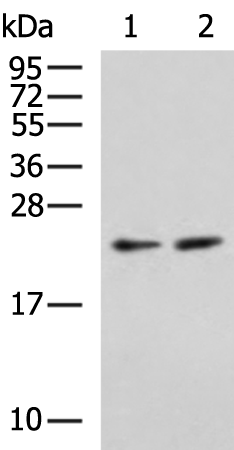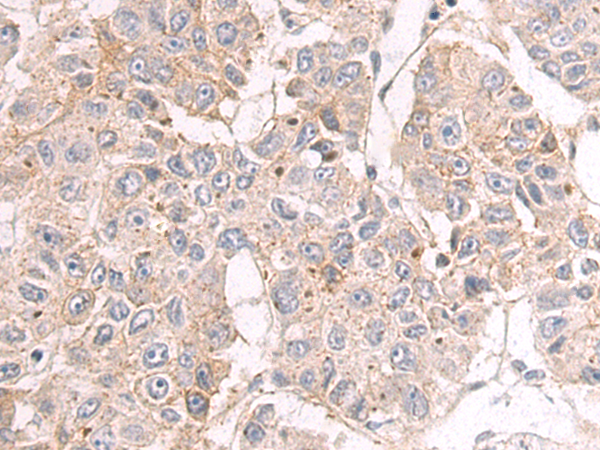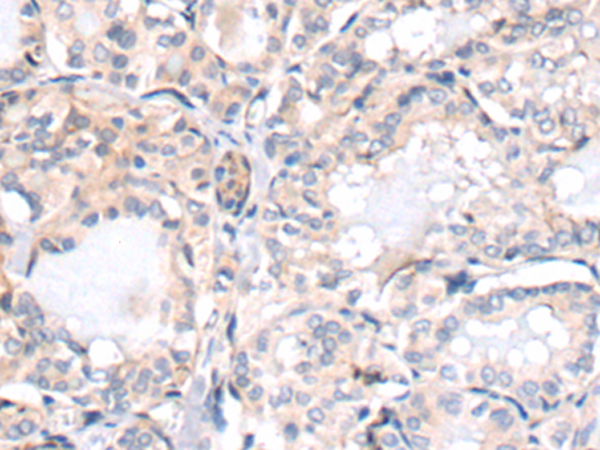


| WB | 咨询技术 | Human,Mouse,Rat |
| IF | 咨询技术 | Human,Mouse,Rat |
| IHC | 1/50-1/200 | Human,Mouse,Rat |
| ICC | 技术咨询 | Human,Mouse,Rat |
| FCM | 咨询技术 | Human,Mouse,Rat |
| Elisa | 1/5000-1/10000 | Human,Mouse,Rat |
| Aliases | JFY1; PUMA; JFY-1 |
| WB Predicted band size | 21 kDa |
| Host/Isotype | Rabbit IgG |
| Antibody Type | Primary antibody |
| Storage | Store at 4°C short term. Aliquot and store at -20°C long term. Avoid freeze/thaw cycles. |
| Species Reactivity | Human |
| Immunogen | Synthetic peptide of human BBC3 |
| Formulation | Purified antibody in PBS with 0.05% sodium azide and 50% glycerol. |
+ +
以下是关于BBC3(PUMA)抗体的3篇参考文献及其摘要概括:
1. **文献名称**:PUMA mediates the apoptotic response to p53 in colorectal cancer cells
**作者**:Yu, J. et al.
**摘要**:该研究首次克隆并鉴定了BBC3/PUMA作为p53依赖性凋亡的关键介质,使用BBC3抗体在结直肠癌细胞中通过Western blot证实其在DNA损伤后的表达上调,并证明其通过激活线粒体凋亡通路诱导细胞死亡。
2. **文献名称**:PUMA, a novel proapoptotic gene, is induced by p53
**作者**:Nakano, K. & Vousden, K.H.
**摘要**:研究揭示了PUMA/BBC3受p53转录调控的机制,通过抗体检测发现其在多种癌细胞中响应放疗/化疗药物时显著表达,并证明其缺失可抑制凋亡,为靶向治疗提供依据。
3. **文献名称**:Puma is an essential mediator of oncogenic stress-induced apoptosis
**作者**:Jeffers, J.R. et al.
**摘要**:该文献利用BBC3抗体进行免疫组化分析,发现PUMA在肿瘤组织中高表达,且其水平与化疗敏感性相关,进一步通过基因敲除实验证实其在癌基因异常激活时触发凋亡的作用。
4. **文献名称**:Role of PUMA in the apoptotic response to hypoxia
**作者**:Han, J. et al.
**摘要**:研究探讨低氧条件下PUMA/BBC3的调控机制,通过抗体共沉淀实验揭示其与抗凋亡蛋白BCL-2的相互作用,并证明其在缺血再灌注损伤模型中的关键功能。
(注:上述内容基于领域内经典研究概括,实际文献引用需核对原文。)
BBC3 (BCL-2 Binding Component 3), also known as p53-upregulated modulator of apoptosis (PUMA), is a pro-apoptotic protein belonging to the Bcl-2 family. It plays a critical role in apoptosis by interacting with anti-apoptotic Bcl-2 family members (e.g., Bcl-2. Bcl-xL) to trigger mitochondrial outer membrane permeabilization, releasing cytochrome c and activating caspases. BBC3 is transcriptionally regulated by p53 under DNA damage or cellular stress, though p53-independent pathways (e.g., glucocorticoids, growth factor withdrawal) can also induce its expression.
BBC3 antibodies are essential tools for studying apoptosis mechanisms, particularly in cancer research, where PUMA's dual role as a tumor suppressor and chemotherapy response mediator is of interest. These antibodies enable detection of PUMA expression via techniques like Western blotting, immunohistochemistry, and flow cytometry. Researchers use them to explore PUMA's involvement in diseases, including neurodegenerative disorders, ischemic injuries, and immune responses. Specific antibody validation is crucial due to potential cross-reactivity with other Bcl-2 family proteins. Recent studies focus on BBC3's therapeutic potential, such as sensitizing cancer cells to treatment or protecting healthy cells in toxicity models. Its dynamic regulation and context-dependent functions continue to drive demand for high-quality BBC3 antibodies in biomedical research.
×